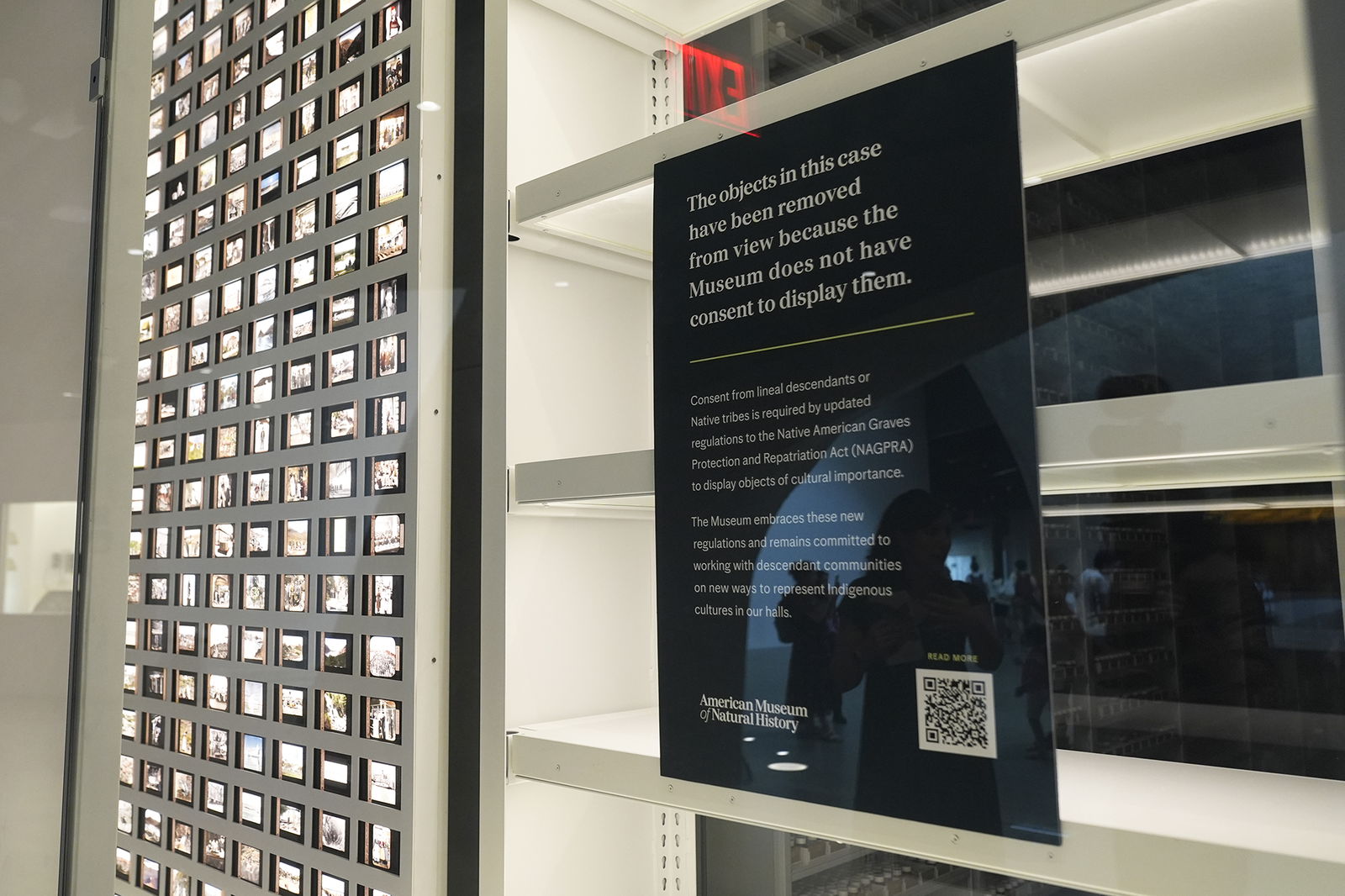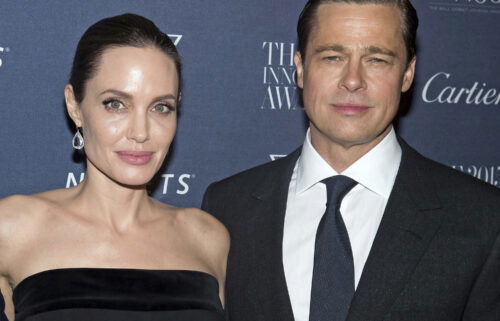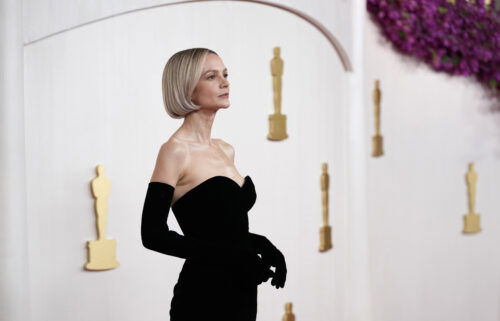Guilty pleasures

By NewsPress Now
Museums closed Native American exhibits 6 months ago, but Tribes are still waiting
NEW YORK | Tucked within the expansive Native American halls of the American Museum of Natural History is a diminutive wooden doll that holds a sacred place among the tribes whose territories once included Manhattan.
For more than six months now, the ceremonial Ohtas, or Doll Being, has been hidden from view after the museum and others nationally took dramatic steps to board up or paper over exhibits in response to new federal rules requiring institutions to return sacred or culturally significant items to tribes — or at least to obtain consent to display or study them.
The doll, also called Nahneetis, is just one of some 1,800 items museum officials say they’re reviewing as they work to comply with the requirements while also eyeing a broader overhaul of the more than half-century-old exhibits.
But some tribal leaders remain skeptical, saying museums have not acted swiftly enough. The new rules, after all, were prompted by years of complaints from tribes that hundreds of thousands of items that should have been returned under the federal Native American Graves Protection and Repatriation Act of 1990 still remain in museum custody.
“If things move slowly, then address that,” said Joe Baker, a Manhattan resident and member of the Delaware Tribe of Indians, descendants of the Lenape peoples European traders encountered more than 400 years ago. “The collections, they’re part of our story, part of our family. We need them home. We need them close.”
Sean Decatur, the New York museum’s president, promised tribes will hear from officials soon. He said staff these past few months have been reexamining the displayed objects in order to begin contacting tribal communities.
The museum also plans to open a small exhibit in the fall incorporating Native American voices and explaining the history of the closed halls, why changes are being made and what the future holds, he said.
Museum officials envision a total overhaul of the closed Eastern Woodlands and Great Plains halls — akin to the five-year, $19 million renovation of its Northwest Coast Hall, completed in 2022 in close collaboration with tribes, Decatur added.
“The ultimate aim is to make sure we’re getting the stories right,” he said.
Lance Gumbs, vice chairman of the Shinnecock Indian Nation, a federally recognized tribe in New York’s Hamptons, said he worries about the loss of representation of local tribes in public institutions, with exhibit closures likely stretching into years.
The American Museum of Natural History, he noted, is one of New York’s major tourism draws and also a mainstay for generations of area students learning about the region’s tribes.
He suggests museums use replicas made by Native peoples so that sensitive cultural items aren’t physically on display.
“I don’t think tribes want to have our history written out of museums,” Gumbs said. “There’s got to be a better way than using artifacts that literally were stolen out of gravesites.”
Gordon Yellowman, who heads the department of language and culture for the Cheyenne and Arapaho Tribes, said museums should look to create more digital and virtual exhibits.
He said the tribes, in Oklahoma, will be seeking from the New York museum a sketchbook by the Cheyenne warrior Little Finger Nail that contains his drawings and illustrations from battle.
The book, which is in storage and not on display, was plucked from his body after he and other tribe members were killed by U.S. soldiers in Nebraska in 1879.
“These drawings weren’t just made because they were beautiful,” Yellowman said. “They were made to show the actual history of the Cheyenne and Arapaho people.”
Institutions elsewhere are taking other approaches.
In Chicago, the Field Museum has established a Center for Repatriation after covering up several cases in its halls dedicated to ancient America and the peoples of the coastal Northwest and Arctic.
The museum has also since returned four items back to tribes, with another three pending, through efforts that were underway before the new regulations, according to spokesperson Bridgette Russell.
At the Cleveland Museum in Ohio, a case displaying artifacts from the Tlingit people in Alaska has been reopened after their leadership gave consent, according to Todd Mesek, the museum’s spokesperson. But two other displays remain covered up, with one containing funerary objects from the ancient Southwest to be redone with a different topic and materials.
And at Harvard, the Peabody Museum’s North American Indian hall reopened in February after about 15% of its roughly 350 items were removed from displays, university spokesperson Nicole Rura said.
Chuck Hoskin, chief of the Cherokee Nation, said he believes many institutions now understand they can no longer treat Indigenous items as “museum curiosities” from “peoples that no longer exist.”
The leader of the tribe in Oklahoma said he visited the Peabody this year after the university reached out about returning hair clippings collected in the early 1930s from hundreds of Indigenous children, including Cherokees, forced to assimilate in the notorious Indian boarding schools.
“The fact that we’re in a position to sit down with Harvard and have a really meaningful conversation, that’s progress for the country,” he said.
As for Baker, he wants the Ohtas returned to its tribe. He said the ceremonial doll should never have been on display, especially arranged as it was among wooden bowls, spoons and other everyday items.
Museum officials say discussions with tribal representatives began in 2021 and will continue, even though the doll technically does not fall under federal regulations because it’s associated with a tribe outside the U.S., the Munsee-Delaware Nation in Ontario.
“It has a spirit. It’s a living being,” Baker said. “So if you think about it being hung on a wall all these years in a static case, suffocating for lack of air, it’s just horrific, really.”
Princess Leia bikini costume sold at auction
HOUSTON | The gold bikini-style costume that Carrie Fisher wore as Princess Leia while making “Return of the Jedi” in the “Star Wars” franchise has sold for $175,000, according to the auction house that handled the sale.
The costume was made famous when Fisher wore it at the start of the 1983 film when Leia was captured by Jabba the Hutt at his palace on Tatooine and forced to be a slave.
The costume, one of the most memorable in the “Star Wars” movies, was sold on Friday by Dallas-based Heritage Auctions.
Joe Maddalena, Heritage’s executive vice president, said the costume that was sold was one that was screen tested and worn by Fisher on the movie’s set but ultimately did not make it onto the final version of the film as it was switched out for one that was more comfortable.
The auction house said the costume sparked a bidding war among collectors.
Maddalena said he wasn’t surprised by the attention bidders gave to the costume as well as to a model of a Y-wing fighter that took on the Death Star in the original “Star Wars” film that sold for $1.55 million. He said “Star Wars” and “Star Trek” have very avid fan bases.
“The power of ‘Star Wars’ proves itself again. These movies are just so impactful,” Maddalena said.
In a November 2016 interview with NPR’s “Fresh Air,” Fisher said wearing the costume was not her choice.
“When (director George Lucas) showed me the outfit, I thought he was kidding and it made me very nervous. I had to sit very straight because I couldn’t have lines on my sides, like little creases. No creases were allowed, so I had to sit very, very rigid straight,” said Fisher, who died about a month after the interview.
Richard Miller, who created the costume, said in an interview that’s included in a “Star Wars” box set that he used soft material to build the costume so that Fisher could move around more freely.
“However, she still didn’t like it. I don’t blame her,” said Miller, who was the chief sculptor for Industrial Light & Magic, the visual effects company founded by “Star Wars” creator George Lucas. “I did put leather on the back of it to help it feel better.”
The costume had its share of critics, who thought it sexualized Fisher for the franchise’s male fan base.
In “Interview” magazine in 2015, Fisher told actor Daisy Ridley, who starred in “Star Wars: The Force Awakens,” “You’re going to have people have fantasies about you. That will make you uncomfortable, I’m guessing.” She pushed back against the idea of being a sex symbol and told Ridley to “fight for your outfit.”
‘Deadpool & Wolverine’ now has the 6th biggest opening weekend of all time
“Deadpool & Wolverine” had a better Sunday than anticipated. The comic book film earned $211 million in its first weekend in North American theaters, Disney said Monday.
That’s $6 million more than was estimated on Sunday, putting “Deadpool & Wolverine” in a different league. It had already broken the record for an R-rated movie. But the Shawn Levy-directed film starring Ryan Reynolds and Hugh Jackman now boasts the sixth highest opening weekend of all time, surpassing “Jurassic World” which opened to $208.8 million in 2015.
The Walt Disney Co. can now claim five of the six biggest box office openings ever, not accounting for inflation, including two “Avengers” movies, “Endgame” and “Infinity War,” and two “Star Wars” films, “The Force Awakens” and “The Last Jedi.” The only outlier is the second-place holder “Spider-Man: No Way Home,” which was released by Sony and produced by Marvel Studios.
“Deadpool & Wolverine’s” overperformance also boosted its global number to $444.3 million, surpassing “Avatar: The Way of Water.”
—From AP reports



